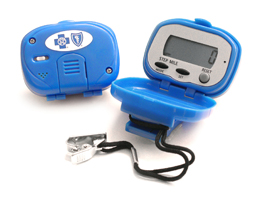
| Newsroom | Health Professionals | Employers | Federal Employees | Public Policy Specialists | ||||||||
 |
||
|
Starting the WalkingWorks Program The U.S. Surgeon General reports that a minimum of 30 minutes of moderate physical activity, such as brisk walking, on most days of the week can produce long-term health benefits. The President's Council on Physical Fitness and Sports recommends at least 30 minutes a day, on five or more days a week, or 10,000 steps daily, measured by a pedometer. WalkingWorks is designed for everyone, so even if you have a chronic health condition or are seriously overweight, or if you are already in great shape, you will learn how to set a goal that makes sense for you. While 10,000 steps may seem like a lot, you're probably walking more than you think. And by making simple choices like taking the stairs instead of the elevator, walking to the store instead of driving, parking at the back of the parking lot instead of the front — you'll be surprised at how quickly the steps add up. Add 30 to 60 minutes of brisk-paced walking a day and you're there! On this Web site, you'll find everything you need to start a regular walking routine — no matter what your fitness level. All you really need is a good pair of shoes. Your WalkingWorks Plan To avoid injury, consider starting out slowly. Unless you are already walking a lot, it may take a while before you reach the 10,000 steps goal. Follow these steps to establish your individual goal and shape your program:
Keep in mind that 10,000 steps may not be a realistic goal for everyone. If you are very overweight or have other chronic health problems, talk with your doctor to determine a goal that may be more appropriate. Is 10,000 Steps Too Few for You? For some people, 10,000 steps are too few to meet ultimate health or weight loss goals. For example, individuals who are already walking 7,000 or 8,000 steps per day may not get enough benefit from increasing to just 10,000. If this applies to you, ultimately aim to add a total of 7,600 steps to your current daily total, adding 500 steps every two weeks as indicated in the plan. You can also add hills, stairs, or arm weights to your routine, to make your walks more challenging.
|
Starting the WalkingWorks Program Blue Cross and Blue Shield Plan Programs Keeping Quality Healthcare Affordable
|
|
| National Healthcare Issues | BlueCard® Doctor & Hospital Finder | Listing of Blue Companies | Questions |
| Who We Are | Glossary | Privacy Statement | Terms & Conditions |
An Association of Independent Blue Cross Blue Shield Plans. All rights reserved.
